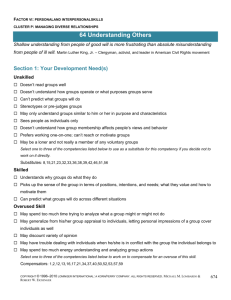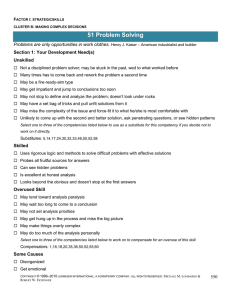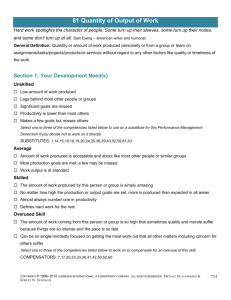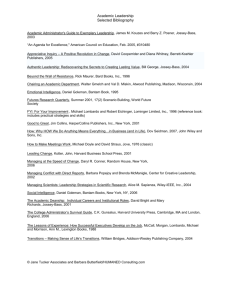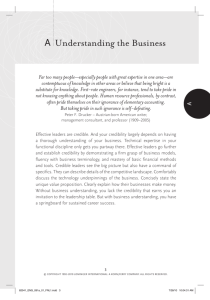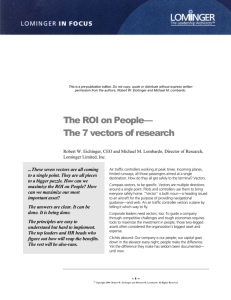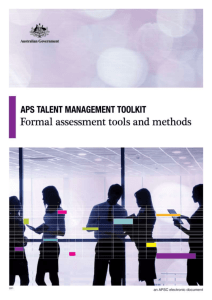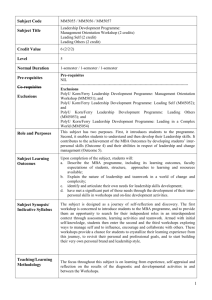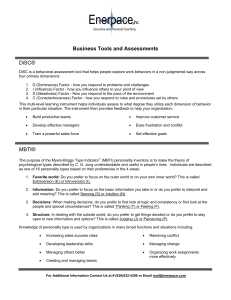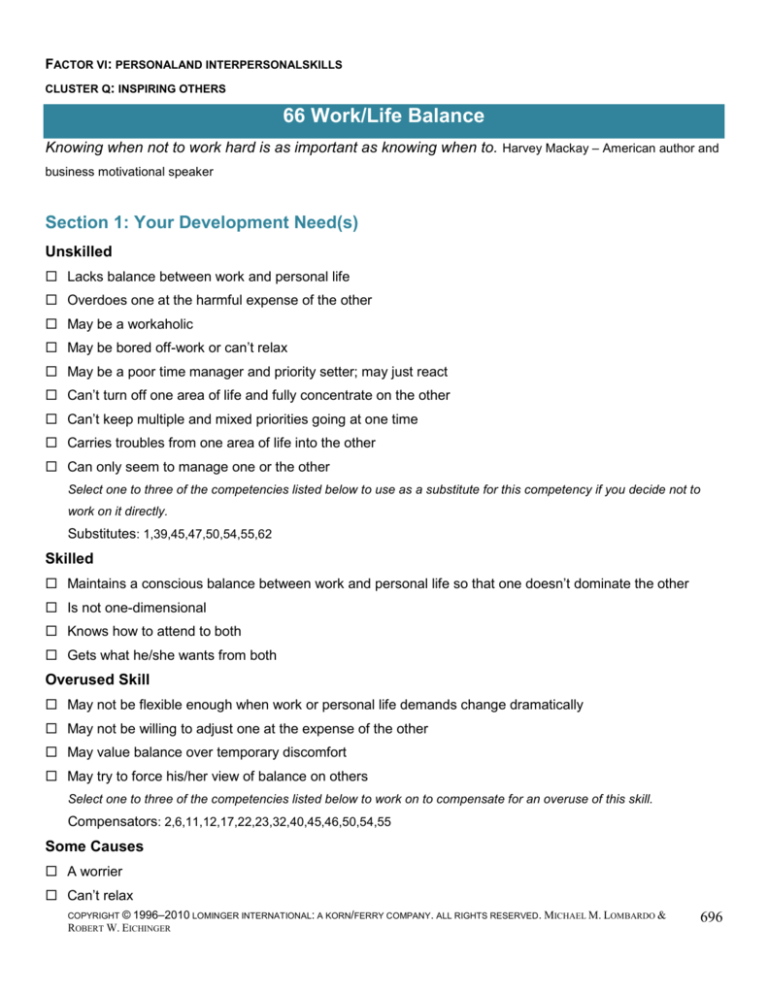
FACTOR VI: PERSONALAND INTERPERSONALSKILLS
CLUSTER Q: INSPIRING OTHERS
66 Work/Life Balance
Knowing when not to work hard is as important as knowing when to. Harvey Mackay – American author and
business motivational speaker
Section 1: Your Development Need(s)
Unskilled
Lacks balance between work and personal life
Overdoes one at the harmful expense of the other
May be a workaholic
May be bored off-work or can’t relax
May be a poor time manager and priority setter; may just react
Can’t turn off one area of life and fully concentrate on the other
Can’t keep multiple and mixed priorities going at one time
Carries troubles from one area of life into the other
Can only seem to manage one or the other
Select one to three of the competencies listed below to use as a substitute for this competency if you decide not to
work on it directly.
Substitutes: 1,39,45,47,50,54,55,62
Skilled
Maintains a conscious balance between work and personal life so that one doesn’t dominate the other
Is not one-dimensional
Knows how to attend to both
Gets what he/she wants from both
Overused Skill
May not be flexible enough when work or personal life demands change dramatically
May not be willing to adjust one at the expense of the other
May value balance over temporary discomfort
May try to force his/her view of balance on others
Select one to three of the competencies listed below to work on to compensate for an overuse of this skill.
Compensators: 2,6,11,12,17,22,23,32,40,45,46,50,54,55
Some Causes
A worrier
Can’t relax
COPYRIGHT © 1996–2010 LOMINGER INTERNATIONAL: A KORN/FERRY COMPANY. ALL RIGHTS RESERVED. MICHAEL M. LOMBARDO &
ROBERT W. EICHINGER
696
Off-work is not exciting
Overly ambitious
Poor priority setting
Time management
Too intense
Workaholic
Leadership Architect® Factors and Clusters
This competency is in the Personal and Interpersonal Skills Factor (VI). This competency is in the Balancing
Work/Life Cluster (U). You may want to check other competencies in the same Factor/Cluster for related tips.
The Map
Research on well-being shows that the best adjusted people are generally the busiest people, on- and offwork. Balance is not achieved only by people who are not busy and have the time. It’s the off-work part of
balance that gives most people problems. With downsizing, wondering if you’ll be in the next layoff, and 60
hour work weeks, many people are too exhausted to do much more than refuel off-work. Nonetheless,
frustration and feeling unidimensional are often the result of not forcing the issue of balance in one’s life. There
is special pressure on those with full dual responsibilities—they have full-time jobs and they have full-time care
giver and home management duties.
Section 2: Learning on Your Own
These self-development remedies will help you build your skill(s).
Some Remedies
1. Overcommitting? Don’t put all your eggs in one basket. Add things to your off-work life. This was a
major finding of a stress study at AT&T of busy, high-potential women and men. It may seem
counterintuitive, but the best adjusted people forced themselves to structure off-work activities just as much
as on-work activities. Otherwise work drives everything else out. Those with dual responsibilities (primary
care giver and home manager and a full-time job holder) need to use their management strengths and
skills more at home. What makes your work life successful? Batch tasks, bundle similar activities together,
delegate to children or set up pools with coworkers or neighbors to share tasks such as car pooling, soccer
games, Scouts, etc. Pay to have some things done that are not mission-critical to your home needs.
Organize and manage efficiently. Have a schedule. Set up goals and plans. Use some of your work skills
more off-work.
COPYRIGHT © 1996–2010 LOMINGER INTERNATIONAL: A KORN/FERRY COMPANY. ALL RIGHTS RESERVED. MICHAEL M. LOMBARDO &
ROBERT W. EICHINGER
697
2. Not sure how to define balance? Learn what works for you. Balance has nothing to do with 50/50 or
clock time. It has to do with how we use the time we have. It doesn’t mean for every hour of work, you must
have an hour off-work. It means finding what is a reasonable balance for you. Is it a few hours a week
unencumbered by work worries? Is it four breaks a day? Is it some solitude before bedtime? Is it playing
with your kids more? Is it having an actual (rather than ―Did you remember the dry cleaning?‖) conversation
with your spouse (partner) each day? Is it a community, religious or sports activity that you’re passionate
about? Schedule them; structure them into your life. Negotiate with your partner; don’t just accept your life
as a given. Define what balance is for you and include your spouse or friends or family in the definition.
3. Weighed down? Concentrate on the present. There’s time and there’s focused time. Busy people with
not much time learn to get into the present tense without carrying the rest of their burdens, concerns and
deadlines with them. When you have only one hour to read or play with the kids or play racquetball or
sew—be there. Have fun. You won’t solve any problems during the 60 minutes anyway. Train your mind to
be where you are. Focus on the moment.
4. Leaving your strengths behind? Create deadlines, urgencies, and structures off-work. One tactic
that helps is for people to use their strengths from work off-work. If you are organized, organize something.
If you are very personable, get together a regular group. If you are competitive, set up a regular match. As
commonsensical as this seems, AT&T found that people with poor off-work lives did not use their strengths
off-work. They truly left them at the office.
5. Can’t say no? Recognize you can’t do it all. What are your NOs? If you don’t have any, chances are
you’ll be frustrated on both sides of your life. Part of maturity is letting go of nice, even fun and probably
valuable, activities. What are you hanging on to? What can’t you say no to at the office that really isn’t a
priority? Where do you make yourself a patsy? If your saying no irritates people initially, this may be the
price. You can usually soften it, however, by explaining what you are trying to do. Most people won’t take it
personally if you say you’re going to pick up your child or maybe coach his/her soccer team or you can’t
help with this project because of an explicit priority which is critical to your unit. Give reasons that don’t
downgrade the activity you’re giving up. It’s not that it’s insignificant; it just didn’t quite make the cut.
6. Bored? Make your off-work life more exciting. Many of us want as little stress as we can get off-work
and seeking this comfort ends up as boredom. What are three really exciting things you and/or your family
could do? Work will always be exciting or at least full of activity. Combating this stimulus overload means
finding something you can be passionate about off the job.
COPYRIGHT © 1996–2010 LOMINGER INTERNATIONAL: A KORN/FERRY COMPANY. ALL RIGHTS RESERVED. MICHAEL M. LOMBARDO &
ROBERT W. EICHINGER
698
7. Can’t get your mind off work? If you can’t relax once you leave work, schedule breakpoints or
boundaries. One of the great things about the human brain is that it responds to change; signal it that
work is over—play music in your car, immediately play with your children, go for a walk, swim for 20
minutes—give your mind a clear and repetitious breakpoint. Try to focus all your energy where you are. At
work, worry about work things and not life things. When you hit the driveway, worry about life things and
leave work things at the office. Schedule a time every week for financial management and worries. Try to
concentrate your worry time where it will do some good.
8. Unable to let go? Compartmentalize. If your problem goes beyond that—you’re three days into
vacation and still can’t relax—write down what you’re worried about, which is almost always unresolved
problems. Write down everything you can think of. Don’t worry about complete sentences—just get it down.
You’ll usually find it’s hard to fill a page and there will be only three topics—work problems, problems with
people, and a to-do list. Note any ideas that come up for dealing with them. This will usually shut off your
worry response, which is nothing but a mental reminder of things unresolved. Since we’re all creatures of
habit, though, the same worries will pop up again. Then you have to say to yourself (as silly as this seems),
―I’ve done everything I can do on that right now,‖ or ―That’s right, I remember, I’ll do it later.‖ Obviously, this
tactic works when we’re not on vacation as well.
9. Do you truly live to work? If you love work, and you’re really a happy but unbalanced workaholic,
try tip #4. If that doesn’t work, you need to see yourself 20 years from now. Find three people who remind
you of you but are 20 years older. Are they happy? How are their personal lives? Any problems with stress
or depression? If this is OK with you, protect yourself with #7. If you don’t do something to refresh yourself,
your effectiveness will eventually suffer or you’ll burn out.
10. Not sure what to do? Talk to people who have your best interests at heart. Seek counsel from
those who accept you for who you are and with whom you can be candid. What do they want for you? Ask
them how they would change your balance.
Section 3: Learning from Feedback
These sources would give you the most accurate and detailed feedback on your skill(s).
1. Development Professionals
Sometimes it might be valuable to get some analysis and feedback from a professional trained and certified
in the area you’re working on—possibly a career counselor, a therapist, clergy, a psychologist, etc.
COPYRIGHT © 1996–2010 LOMINGER INTERNATIONAL: A KORN/FERRY COMPANY. ALL RIGHTS RESERVED. MICHAEL M. LOMBARDO &
ROBERT W. EICHINGER
699
2. Direct Reports
Across a variety of settings, your direct reports probably see you the most. They are the recipients of most
of your managerial behaviors. They know your work. They can compare you with former bosses. Since
they may hesitate to give you negative feedback, you have to set the atmosphere to make it easier for
them. You have to ask.
3. Family Members
On some issues like interpersonal style or compassion, it might be helpful to ask various and multiple
family members for feedback to add confirmation or context to feedback you’ve received in the workplace.
4. Natural Mentors
Natural mentors have a special relationship with you and are interested in your success and your future.
Since they are usually not in your direct chain of com-mand, you can have more open, relaxed, and fruitful
discussions about yourself and your career prospects. They can be a very important source for candid or
critical feedback others may not give you.
5. Yourself
You are an important source of feedback on yourself. But some caution is appropriate. If you have not
received much feedback, you may be less accurate than the other sources. We all have blind spots,
defense shields, ideal self-views, and fantasies. Before acting on your own self-views, get outside
confirmation from other appropriate sources.
Section 4: Learning from Develop-in-Place Assignments
These part-time develop-in-place assignments will help you build your skill(s).
Attend a self-awareness/assessment course that includes feedback.
Join a self-help or support group.
Complete a self-study course or project in an important area for you.
Attend a course or event which will push you personally beyond your usual limits or outside your comfort
zone (e.g., Outward Bound, language immersion training, sensitivity group, public speaking).
Act as a loaned executive to a charity, government agency, etc.
Become an active member of a professional organization.
Work on a project that involves travel and study of an international issue, acquisition, or joint venture and
report back to management.
Represent the organization at a trade show, convention, exposition, etc.
Assign a project with a tight deadline to a group.
COPYRIGHT © 1996–2010 LOMINGER INTERNATIONAL: A KORN/FERRY COMPANY. ALL RIGHTS RESERVED. MICHAEL M. LOMBARDO &
ROBERT W. EICHINGER
700
Take over for someone on vacation, leave of absence, or on a long trip.
Section 5: Learning from Full-Time Jobs
These full-time jobs offer the opportunity to build your skill(s).
1. Cross-Moves
The core demands necessary to qualify as a Cross-Move are: (1) Move to a very different set of
challenges. (2) Abrupt jump/shift in tasks/activities. (3) Never been there before. (4) New setting/conditions.
Examples of Cross-Moves are: (1) Changing divisions. (2) Changing functions. (3) Field/headquarters
shifts. (4) Line/staff switches. (5) Country switches. (6) Working with all new people. (7) Changing lines of
business.
2. International Assignments
The core demands to qualify as an International assignment are: (1) First-time working in the country. (2)
Significant challenges like new language, hardship location, unique business rules/practices, significant
cultural/marketplace differences, different functional task, etc. (3) More than a year assignment. (4) No
automatic return deal. (5) Not necessarily a change in job challenge, technical content, or responsibilities.
Examples of International assignments would be: (1) Managing local operations for an office located
outside your home country. (2) Leading the expansion into new global markets. (3) International sales
position. (4) Country/region head. (5) Managing transition for outsourced operations at an international
location. (6) Head of supply chain or manufacturing for global business. (7) Global compliance manager at
an international post.
3. Staff to Line Shifts
Core demands necessary to qualify for a Staff to Line shift are: (1) Moving to a job with an easily
determined bottom line or results. (2) Managing bigger scope and/or scale. (3) Requires new
skills/perspectives. (4) Unfamiliar aspects of the assignment. Examples of Staff to Line shifts would be: (1)
Moving from support function to business unit with P&L responsibility. (2) Product manager responsible for
product life cycle, revenue projections, and inventory planning. (3) General manager position. (4) Manager
responsible for a region or a product line or brand.
Section 6: Learning from Your Plan
These additional remedies will help make this development plan more effective for you.
Learning to Learn Better
1. Study Yourself in Detail
COPYRIGHT © 1996–2010 LOMINGER INTERNATIONAL: A KORN/FERRY COMPANY. ALL RIGHTS RESERVED. MICHAEL M. LOMBARDO &
ROBERT W. EICHINGER
701
Study your likes and dislikes because they can drive a lot of your thinking, judging, and acting. Ask which
like or dislike has gotten in the way or prevented you from moving to a higher level of learning. Are your
likes and dislikes really important to you or have you just gone on ―autopilot‖? Try to address and
understand a blocking dislike and change it.
Learning from Experience, Feedback, and Other People
2. Learning from Ineffective Behavior
Seeing things done poorly can be a very potent source of learning for you, especially if the behavior or
action affects others negatively. Many times the thing done poorly causes emotional reactions or pain in
you and others. Distance yourself from the feelings and explore why the actions didn’t work.
3. Learning from Interviewing Others
Interview others. Ask not only what they do, but how and why they do it. What do they think are the rules of
thumb they are following? Where did they learn the behaviors? How do they keep them current? How do
they monitor the effect they have on others?
4. Learning from Observing Others
Observe others. Find opportunities to observe without interacting with your model. This enables you to
objectively study the person, note what he/she is doing or not doing, and compare that with what you would
typically do in similar situations. Many times you can learn more by watching than asking. Your model may
not be able to explain what he/she does or may be an unwilling teacher.
5. Feedback in Unusual Contexts/Situations
Temporary and extreme conditions and contexts may shade interpretations of your behavior and intentions.
Demands of the job may drive you outside your normal mode of operating. Hence, feedback you receive
may be inaccurate during those times. However, unusual contexts affect our behavior less than most
assume. It’s usually a weak excuse.
If A is a success in life, then A equals x plus y plus z. Work is x; y is play; and z is keeping your mouth
shut. Albert Einstein – German-born Nobel Prize-winning physicist
COPYRIGHT © 1996–2010 LOMINGER INTERNATIONAL: A KORN/FERRY COMPANY. ALL RIGHTS RESERVED. MICHAEL M. LOMBARDO &
ROBERT W. EICHINGER
702
Suggested Readings
Alboher, M. (2007). One person/multiple careers: A new model for work/life success. Boston: Business Plus.
Barsh, J., Cranston, S., & Lewis, G. (2009). How remarkable women lead: The breakthrough model for work
and life. New York: Crown Business.
Bogle, J. C. (2008). Enough: True measures of money, business, and life. Hoboken, NJ: John Wiley & Sons.
Cohen, D., & Prusak, L. (2001). In good company: How social capital makes organizations work. Boston:
Harvard Business School Press.
Deering, A., Dilts, R., & Russell, J. (2002). Alpha leadership: Tools for business leaders who want more from
life. West Sussex, England: John Wiley & Sons.
Ferriss, T. (2007). The 4-hour workweek: Escape 9–5, live anywhere, and join the new rich. New York: Crown
Publishing Group.
Germer, F. (2001). Hard won wisdom: More than 50 extraordinary women mentor you to find self-awareness,
perspective, and balance. New York: Perigee.
Glanz, B. (2003). Balancing acts. Chicago: Dearborn Trade.
Gordon, G. E. (2001). Turn it off: How to unplug from the anytime-anywhere office without disconnecting your
career. New York: Three Rivers Press.
Hakim, C. (2000). Work-lifestyle choices in the 21st century: Preference theory. Oxford, UK: Oxford University
Press.
Harvard Business School Press. (2000). Harvard Business Review on work and life balance. Boston: Harvard
Business School Press.
Jackson, M. (2002). What‘s happening to home: Balancing work, life and refuge in the information age. Notre
Dame, IN: Sorin Books.
Johnson, T., & Spizman, R. F. (2008). Will work from home: Earn the cash—without the commute. New York:
Berkley Publishing Group.
Lewis, S., & Cooper, C. L. (2005). Work-life integration: Case studies of organizational change. West Sussex,
England: John Wiley & Sons.
Mainiero, L. A., & Sullivan, S. E. (2006). The opt-out revolt: Why people are leaving companies to create
kaleidoscope careers. Mountain View, CA: Davies-Black.
Matthews, J., & Dennis, J. (2003). Lessons from the edge: Survival skills for starting and growing a company.
New York: Oxford University Press.
Merrill, A. R., & Merrill, R. R. (2003). Life matters: Creating a dynamic balance of work, family, time and
money. New York: McGraw-Hill.
Muna, F. A., & Mansour, N. (2009). Balancing work and personal life: The leader as acrobat. Journal of
Management Development, 28(2), 121-133.
Peterson, B. D., & Nielson, G. W. (2009). Fake work: Why people are working harder than ever but
accomplishing less, and how to fix the problem. New York: Simon Spotlight Entertainment.
COPYRIGHT © 1996–2010 LOMINGER INTERNATIONAL: A KORN/FERRY COMPANY. ALL RIGHTS RESERVED. MICHAEL M. LOMBARDO &
ROBERT W. EICHINGER
703
Rao, S. (2010). Happiness at work: Be resilient, motivated, and successful—No matter what. New York:
McGraw-Hill.
Sawi, B. (2000). Coming up for air: How to build a balanced life in a workaholic world. New York: Hyperion.
Snow, P. (2010). Creating your own destiny: How to get exactly what you want out of life and work (Rev. ed.).
Hoboken, NJ: John Wiley & Sons.
St. James, E. (2001). Simplify your work life: Ways to change the way you work so you have more time to live.
New York: Hyperion.
Swindall, C. (2010). Living for the weekday: What every employee and boss needs to know about enjoying
work and life. Hoboken, NJ: John Wiley & Sons.
Williams, J. (2000). Unbending gender: Why family and work conflict and what to do about it. Oxford, UK:
Oxford University Press.
COPYRIGHT © 1996–2010 LOMINGER INTERNATIONAL: A KORN/FERRY COMPANY. ALL RIGHTS RESERVED. MICHAEL M. LOMBARDO &
ROBERT W. EICHINGER
704

